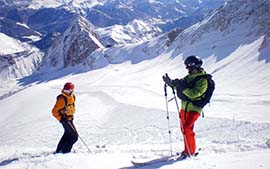Off-Piste Ski Insurance
At DOGTAG Travel Insurance we understand that all competent skiers and snowboarders have ambitions to get off-piste whenever the conditions allow so we don’t see why slipping off the piste to enjoy some new ungroomed powder should be a separate level of cover; it should simply be included in our standard level of winter sports cover.

So, if you chose our Winter Sports Cover (of the appropriate duration) with your Annual Multi Trip, Single Trip or Gap Year insurance, you’ll automatically be covered for in-resort off piste skiing.
What Does Off-Piste Really Mean?
You’ve no doubt noticed that we just said “in-resort off-piste”. So what does it mean?
We often get asked by people looking for off-piste skiing travel insurance what our definition of ‘Off-Piste’ is so we’ve given that below. It also appears in our FAQ’s. You should have a read at this, because it’s important to understand the difference between standard off-piste travel insurance cover and other types of ‘out-of-resort’ skiing and boarding travel insurance such a ‘Back Country”.
Off-Piste – Standard Definitions:
The generally accepted understanding of off-piste skiing or boarding simply means going off of the groomed runs into the unmanaged terrain between runs. These are the areas usually between the marked runs and those easily identified by looking at the boundaries described by the resort’s map. This is our definition of ‘Off Piste’, it offers huge amounts of scope, especially in Europe to ski or snowboard well off the beaten track but without exposing yourself to any risks that have not already been quantified by the resort authorities. And it’s as much as most people are content to do. For this sort of ‘off piste’ we are happy tell you that our default, lowest level of sport or activity cover “Sport” (as opposed to Sport+, Extreme or Extreme+) will give you the off piste skiing cover you’re looking for. Of course, you should never go into areas that have been roped off or where the resort authorities have posted any kind of no-go notice.
By the way, no matter what type of skiing or snowboarding you intend to do, you will also require to select the Winter Sports cover upgrade. However, if you select Skiing – off piste (in resort) in the sport selector as you’re going for a quote, our system will select both the correct Sport level and the Winter Sports cover upgrade automatically.
What About Other Types Of Off Piste?
Often, when people talk about going ‘off piste’, they’re really talking about something which we think is slightly more exotic and a bit riskier. Going outwith the resort into areas that are not managed for the likes of avalanche or where the ski patrols don’t patrol is usually called something like ‘going out of bounds’ or ‘back country’ skiing. These terms have migrated over to the UK where they are falling into more common use and for good reasons. In the USA, if you go ‘out of bounds’ without a permit, you could end up helping the Sherriff with his enquiries or at least having your ticket confiscated, but in Europe, you’re not committing an offence. However you are going into an area that exposes you to more risk. Accordingly, we term this ‘Back Country’ skiing or snowboarding and we rate it differently from simple in-resort off piste.
It goes something like this:
Back Country with a Guide
If you are going out of bounds or outside marked areas of the resort, in other words, “back country”, we recommend that you do so with a fully qualified local guide because, in our view (and in our own experience), you will be taken to the best areas and you’ll have a higher degree of comfort concerning your safety. If you go “Back Country” skiing with a guide, you will need to select Sport+ as your sport cover level, as well, of course, as the additional Winter Sports cover upgrade.
Back Country Without a Guide
We do not insist that you take a guide when you go ‘out of bounds’ or ‘back country’ but we do rate this slightly higher, for obvious reasons: you are venturing into uncharted terrain and you do not have anybody with you who knows the terrain and the risks attached. Accordingly, we rate this slightly higher than going back country with a guide: you’ll need to make sure you select Extreme as your sport cover level – as well, of course, as Winter Sports cover upgrade which is required for every winter sport from ice hockey to ice climbing.
The law:
As we mentioned above, in many parts of North America, going out of bounds or ‘back country’ contravenes local law and you may, at best have your lift pass confiscated or worse, face arrest and have an overnight stay courtesy of the Sherriff’s office. Normally there is a physical fence with warning signs so you shouldn’t be in any doubt.
Be Aware:
It is your responsibility to ensure that on any particular day you are aware of and obey local advice, information and instructions given by the resort authorities and that you obey any signs and information you encounter on the mountain – the source of this information will vary resort to resort and country to country and it is your responsibility to find it out. If a section is marked ‘closed’ there will be a very good reason for it (e.g. high avalanche danger) and ignoring such signs or advice may invalidate your cover. You should be aware that under the terms of cover, needless self-exposure to peril except in an endeavour to save human life may invalidate your cover.
Obviously, it goes without saying, you must never ski off-piste alone.
Other types of “off-piste” skiing.
There are several other types of skiing where you will venture off-piste, out of the resort or ‘out of bounds’ but for which you require a higher level of cover, say, Sport+ or Extreme. This is because these specific types of off-piste are innately more risky that venturing off-piste according to the above definition.
If, for instance you intend to venture off-piste by helicopter, most commonly known as ‘heliskiing’ or ‘heliboarding’ or its close relative, ‘Cat’-skiing and boarding or expect that you might be tempted to give it a try when you’re on holiday, then you may need a higher level of cover than you already have. Both of those types of ‘off-piste’ skiing require our Sport+ level of cover.
Similarly, Ski Mountaineering and Ski Touring are sports which can take you into the wild and untracked places of the mountains. Plainly, the risks of exposure to cold, fatigue and injury are greater here than in other commonly skied areas of the mountains. Consequently, both of these types of ‘off-piste’ activity require DOGTAG Extreme cover. If you chose the Extreme level of cover for say, Ski Mountaineering, it will automatically cover you for lower Sport+ and Sport grades of skiing too. If you want to know which category each sport falls into just check the Sports List.
As a general rule, if you are using ski mountaineering equipment and accessing areas not served by lift, gaining height by “skinning” or climbing or hiking, then you are ski mountaineering and should ensure you have the right level of cover in place.
Equipment and Safety:
Having adequate off-piste insurance is all very well but in order to get the maximum enjoyment and to minimise risk, you should take stock of a few issues: make sure your kit is in full working order, that you are fit enough to undertake the physical exertion required when skiing or snowboarding off-piste, that you have the necessary skills and that you have appropriate safety equipment. For instance, a helmet is considered de rigueur these days for all the right reasons. If you think that you might be tempted to venture into a wooded area then it is complete madness to go there without adequate head protection so… get a lid. You’ll also find that it’s easier to control your temperature with a helmet with adjustable vents than it is, say, with a wooly hat. And a woolly hat isn’t tree-proof.
Avalanche safety and all the related equipment is a book in itself. Our view is simple: the equipment is useless without the training and a large dollop of common sense. Remember, you are in charge of your own safety and deliberately putting yourself in harms way and/or taking foolish risks can compromise your cover – as it can with any other type of insurance.
Will I automatically get Helicopter Rescue?
Well the answer to that is errr…. No and Yes:
Ski patrollers are generally very well trained and experienced at assessing injuries and managing the evacuation of the injured person off the mountain and to hospital in the manner most appropriate to the injured person’s condition. They decide what is appropriate for the circumstances regardless of who insures you. Serious cases often involve helicopters and if it’s medically needed, it will be covered but, more often, a combination of sled and ski lift is more immediate and appropriate. Other factors such as weather are also taken into account. Again, it is not uncommon to be asked for proof of insurance whilst on the mountain.
If you absolutely want more control over how you’ll be rescued then you could do worse than get worldwide rescue membership from Global Rescue, it’s relatively inexpensive and might give you the peace of mind you’re looking for.
You can find some other useful information regarding sports that we cover in our Sports Information Library.
The DOGTAG Team
p.s. if you think this information was useful, why not recommend it to a friend using one of the links below.
